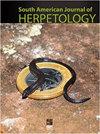A New Species of Parrot-Snake of the Genus Leptophis Bell, 1825 (Serpentes, Colubridae) from the Semi-Arid Region of Brazil
IF 0.7
4区 生物学
Q4 ZOOLOGY
引用次数: 2
Abstract
Abstract. We describe a new species of Leptophis from the Caatinga ecoregion encompassing the semi-arid region of Brazil. Phylogenetic analysis of 16S rDNA sequences indicate that the new species is nested deep within the L. ahaetulla complex. The new species differs from all other congeners in the following unique character combination: two dorsolateral Light Emerald Green (142) to Robin's Egg Blue (161) stripes separated from each other by Pale Buff (1) to Smoke Gray (266) vertebral stripe (continuous to tail) present; loreal scale absent; maxillary teeth 21–24; ventrals 158–177; subcaudals 137–162; black spots on head absent; supracephalic plates of head not edged with black pigment; adult color pattern lacking dark oblique bands; keels absent on first dorsal scale rows; hemipenis unilobed, capitate, with undivided sulcus spermaticus. The new species is distinguished from L. ahaetulla ahaetulla by the Light Emerald Green (142) to Robin's Egg Blue (161) (in life) dorsolateral stripes separated from each other by a Pale Buff (1) to Smoke Gray (266) vertebral stripe (at least anteriorly), and by having white to Pale Sulphur Yellow (92) scales on the first (on anterior region of body) to fourth (midbody region) scale rows [vs. Light Grass Green (109) to Light Emerald Green (142) with Yellow Ocher (14), Cinnamon-Drab (50) or Sulphur Yellow (80) vertebral stripe; second to third—occasionally the fourth—scale rows Sulphur Yellow (80), at least anteriorly], wider snout (vs. narrow), postocular stripe wider (vs. narrow), basal region of hemipenis with 10–14 spines and first row of hemipenial body with 8–9 spines (vs. 18–22 in the basal region and 5–8 in the first row). The new species differs from L. a. liocercus, which is also distributed in the Northeast Region Brazil with a small overlap in distribution, by the dorsolateral stripes (vs. dorsum unstriped), and 18–22 spines in the fourth row of the hemipenial body (vs. 11–18). Recognition of the new species is also consistent with uncorrected pairwise distances between 16S rDNA sequences.标题1825年巴西半干旱区Leptophis Bell属鹦鹉蛇一新种(蛇纲,蛇科)
摘要我们描述了一个新的物种从卡廷加生态区域包括巴西半干旱地区的leptopi。16S rDNA序列的系统发育分析表明,该新种嵌套在haetulla复合体的深处。新种与所有其他同属物种的不同之处在于以下独特的特征组合:两个背侧浅翡翠绿(142)到罗宾蛋蓝(161)条纹,由淡黄色(1)到烟灰色(266)的椎条纹(连续到尾部)分开;无局部尺度;上颌牙21-24;腹侧158 - 177;subcaudals 137 - 162;头部无黑点;头的上片没有黑色颜料镶边;成人彩色图案缺乏暗斜带;龙骨在第一背部鳞片排上无;半阴茎不裂,头状,具未裂的精沟。新物种与阿哈图拉(L. ahaetulla ahaetulla)的区别在于:浅翡翠绿(142)到Robin's Egg Blue(161)(在生活中)的背侧条纹,由淡浅黄色(1)到烟灰色(266)的椎条纹(至少在前面)彼此隔开,并且在第一排(身体前部)到第四排(身体中部)鳞片上有白色到淡硫黄色(92)的鳞片[相对于浅草绿(109)到浅翡翠绿(142)和黄赭石(14)]。褐褐色(50)或硫黄色(80)椎条纹;第二至第三-偶尔第四鳞片排硫黄色(80),至少在前面],较宽的吻部(相对较窄),毛后条纹较宽(相对较窄),半阴茎基部有10-14刺,半阴茎体第一行有8-9刺(相对于基部18-22和第一行5-8)。该新种与同样分布于巴西东北地区的L. a. liocercus的不同之处在于背侧条纹(相对于背侧无条纹)和半头体第4排18-22根刺(相对于11-18)。新物种的识别也与16S rDNA序列之间未校正的成对距离一致。
本文章由计算机程序翻译,如有差异,请以英文原文为准。
求助全文
约1分钟内获得全文
求助全文
来源期刊
CiteScore
1.50
自引率
0.00%
发文量
10
期刊介绍:
The South American Journal of Herpetology (SAJH) is an international journal published by the Brazilian Society of Herpetology that aims to provide an effective medium of communication for the international herpetological community. SAJH publishes peer-reviewed original contributions on all subjects related to the biology of amphibians and reptiles, including descriptive, comparative, inferential, and experimental studies and taxa from anywhere in the world, as well as theoretical studies that explore principles and methods.

 求助内容:
求助内容: 应助结果提醒方式:
应助结果提醒方式:


